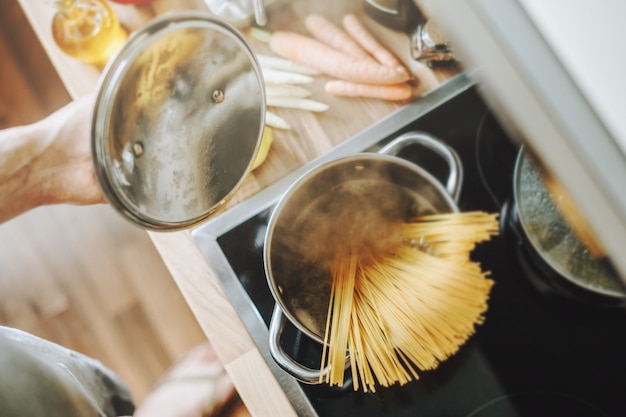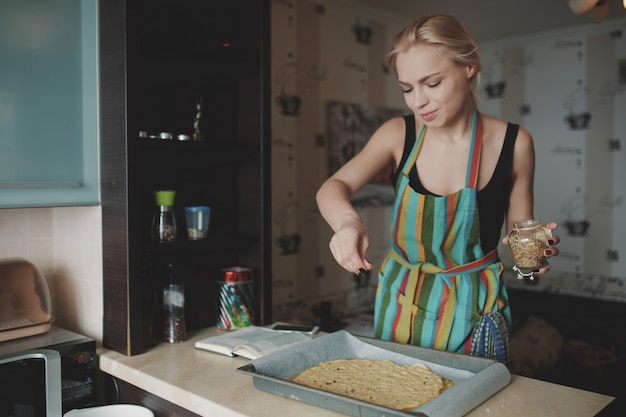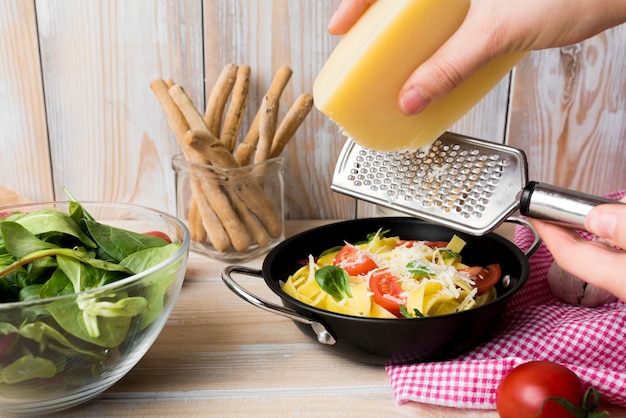Ah, spaghetti squash. It’s a kitchen staple for anyone looking for a healthy, delicious, and easy way to enjoy pasta. But finding that perfect bake time can be a bit of a culinary puzzle. Overcook it, and you’re left with mushy, watery “noodles.” Undercook it, and you’ll be left with a tough, inedible mess. Been there, done that, got the t-shirt (or rather, the stained apron!). But fear not, my fellow food lovers! I’ve got you covered with my tried and true method for achieving that sweet spot – the perfect spaghetti squash bake time.
Part 1: The Basics

Why Choose Spaghetti Squash?
Beyond its fun name, spaghetti squash truly is a kitchen chameleon. It’s not just a pretty face. This versatile veggie shines as a side dish, main course, or even a base for a salad. But let’s be honest – the “noodles” are the real star of the show. They’re a guilt-free alternative to pasta, soaking up flavours like a sponge and providing a satisfyingly hearty texture. Plus, they’re just fun to eat! Who doesn’t love twirling those golden strands around their fork?
The Importance of Size
Before we dive into the baking process, let’s talk about size. Spaghetti squash comes in all shapes and sizes, which directly impacts the bake time. A tiny, little squash might only need 30-40 minutes, while a big, honking one could take closer to an hour. So, it’s crucial to consider the size of your squash before setting the timer!
Part 2: Prepping Your Squash

Preheating the Oven – A Must!
First things first, crank up your oven to 400°F (200°C). We want that oven nice and hot to give our squash a good roasting, so don’t skimp on the preheating time! I always preheat my oven for at least 10 minutes before popping the squash in. This ensures an even bake and helps prevent any soggy surprises.
The All-Important Prick
Now, onto the squash. Remember, spaghetti squash is a bit of a hothead! You’ll want to give it a good prick with a fork. This lets the steam escape, which keeps it from exploding in your oven. It’s not pretty, folks. I’ve seen it happen, and it’s definitely not something you want to experience! Just trust me on this one.
Cut, Scoop, and Conquer
Next, we’re going to cut the squash in half. A sharp knife is your best friend here, but use it with caution! A sturdy cutting board and a good pair of kitchen gloves are your allies in this battle. Once it’s cut in half, it’s time to scoop out the seeds and stringy bits. Don’t throw those seeds away! They’re a tasty treat. Toast them up for a nutty snack or sprinkle them on top of your finished squash.
Part 3: The Bake Time

The General Rule (But Not Always!)
So, the general rule of thumb is to bake a spaghetti squash for 30-45 minutes, or until it’s tender enough to easily pierce with a fork. But here’s the catch: that’s just a starting point. Remember, each squash is unique! That’s why I always do a little “squash test” to make sure it’s perfectly cooked before calling it a day.
The Squash Test: Your Secret Weapon
The squash test is simple but oh-so-important. Just stick a fork into the thickest part of the squash. If it goes in easily and the squash feels soft and tender, you’re golden! If it feels resistant, give it a few more minutes in the oven. I usually add it in 5-minute increments to avoid overcooking.
Part 4: Avoiding Overcooked Squash
Overcooked Squash: A Culinary Tragedy
We all want that perfectly cooked spaghetti squash – those soft, pillowy “noodles” that melt in your mouth. But overcooking is a real danger! It can turn those beautiful “noodles” into a mushy, watery mess, and nobody wants that!
Signs of Overcooked Squash: Beware!
Here are some telltale signs that your squash is on the verge of overcooking:
- Excessive browning. If the surface of the squash starts to brown too much, it’s a sign that it’s getting too hot.
- Extra-soft flesh. If the flesh feels extremely soft and mushy, it’s likely overcooked.
- Watery “noodles.” If the “noodles” start to separate and become watery, they’ve been in the oven for too long.
What to Do If You Overcook (Don’t Panic!)
Don’t fret if you overcook your squash! There are a few things you can do to salvage the situation.
- Scrape those “noodles.” Carefully use a fork to scrape the “noodles” off the shell, starting with the most overcooked parts. The good news is that overcooked parts come off easily.
- Amp up the flavor. A drizzle of olive oil, a sprinkle of herbs, or a tangy sauce can help disguise the overcooked flavor.
- Embrace the mash. If it’s too far gone to be “noodles,” you can mash it up and use it as a base for a soup or casserole.
Part 5: The “Noodle” Factor
Achieving Noodle Perfection
Let’s talk about the most important part: those “noodles.” You want them to be tender yet firm, with a delightful bite. Here’s how to get those perfect “noodles”:
- Avoid overbaking. Remember the squash test! Don’t bake it any longer than necessary.
- Gently scrape. Use a fork to gently scrape the “noodles” off the shell. You want to separate them without tearing them apart.
- Toss with love. A light drizzle of olive oil or a sauce helps keep the “noodles” from sticking and adds a boost of flavor.
Part 6: Storage and Leftovers
Storing Cooked Squash
If you have leftover cooked spaghetti squash, store it in an airtight container in the fridge for up to 3 days. It’s best to store the “noodles” separate from the shells to prevent them from getting soggy.
Reheating Your Squash
When you’re ready to enjoy those leftovers, you can reheat them in the microwave or oven. For the microwave, reheat for 30-60 seconds, or until heated through. If using the oven, bake at 350°F (175°C) for 10-15 minutes.
Part 7: Serving Suggestions
The Flavorful Possibilities Are Endless
Now for the fun part – serving suggestions! Spaghetti squash is a true culinary blank canvas. Here are just a few ideas to get your creative juices flowing:
Main Courses
Think of spaghetti squash as your new go-to pasta replacement. Toss it with your favorite sauces, meats, or seafood.
- Marinara and meatballs. This classic combination never disappoints. It’s the ultimate comfort food!
- alfredo sauce and grilled chicken. Creamy, cheesy, and oh-so-satisfying.
- Pesto sauce and shrimp. A light, bright, and flavorful option.
- Spicy tomato sauce and sausage. Add some heat to your meal!
- Creamy mushroom sauce and grilled portobello mushrooms. A delightful vegetarian choice.
side dishes
Add some colour and nutrition to your plate with these side dish ideas:
- Roasted with olive oil and herbs. Simple, satisfying, and delicious.
- Sprinkled with Parmesan cheese. A classic pairing that never fails.
- Drizzled with balsamic vinegar and toasted pine nuts. A touch of elegance for a special meal.
Salads
Add some substance to your salad with these fresh and flavorful options:
- Grilled chicken, fresh vegetables, and a light vinaigrette.
- Chickpeas, feta cheese, and a lemon vinaigrette.
Part 8: FAQs
1. Can I Bake Spaghetti Squash with the Skin On?
Unfortunately, no. The skin is tough and inedible, so it’s best to remove it before baking. You can cut the squash in half, scoop out the seeds, and bake it with the flesh exposed.
2. How Do I Know When Spaghetti Squash is Done?
Remember the fork test? Stick a fork into the thickest part of the squash. If it goes in easily and the squash feels soft and tender, it’s ready. If it’s still resistant, give it a few more minutes in the oven.
3. Can I Freeze Cooked Spaghetti Squash?
Absolutely! Let it cool completely, then store it in an airtight freezer-safe container or bag. You can freeze it for up to 3 months. To reheat, thaw it overnight in the refrigerator or microwave it for a few minutes.
4. What Can I Do With the Seeds?
Those seeds are a culinary treasure! Toast them up for a nutty snack or sprinkle them on top of your finished squash. To toast them, spread them in a single layer on a baking sheet and bake at 350°F (175°C) for 10-15 minutes, or until golden brown and fragrant.
5. Is Spaghetti Squash Really Low in Calories?
It is! One cup of cooked spaghetti squash contains about 40 calories, making it a great option for those looking for a healthy and delicious meal. It’s also a good source of fiber, vitamins, and minerals.
So there you have it! With a little practice and these tips, you’ll be a spaghetti squash baking pro in no time. Get creative, have fun, and enjoy those delicious, guilt-free “noodles!”
Everyone is watching

Prime Rib Roast Cooking Time Chart: Per Pound Guide
Cooking TipsPrime rib roast. Just the name conjures images of lavish dinners, crackling fires, and hearty laughter. It’s ...

How Long to Bake Potatoes in the Oven (Perfect Every Time)
Cooking TipsBaked potatoes are a staple in my kitchen. They're incredibly versatile, delicious, and surprisingly easy to m...

Perfect Rice Every Time: The Ultimate Guide to Cooking Rice
Cooking TipsAs a self-proclaimed foodie, I've always been a bit obsessed with rice. It's the foundation of countless cuisi...

The Ultimate Guide to Cooking Asparagus: Tips, Techniques, and Recipes
Cooking TipsAsparagus. The mere mention of this spring delicacy conjures up images of vibrant green spears, crisp and burs...

Ultimate Guide to Cooking the Perfect Thanksgiving Turkey
Cooking TipsThanksgiving. Just the word conjures up images of overflowing tables laden with delicious food, the scent of r...
